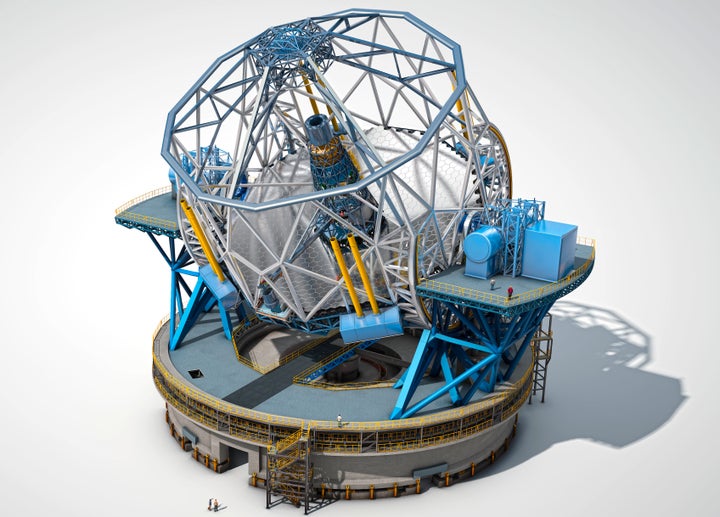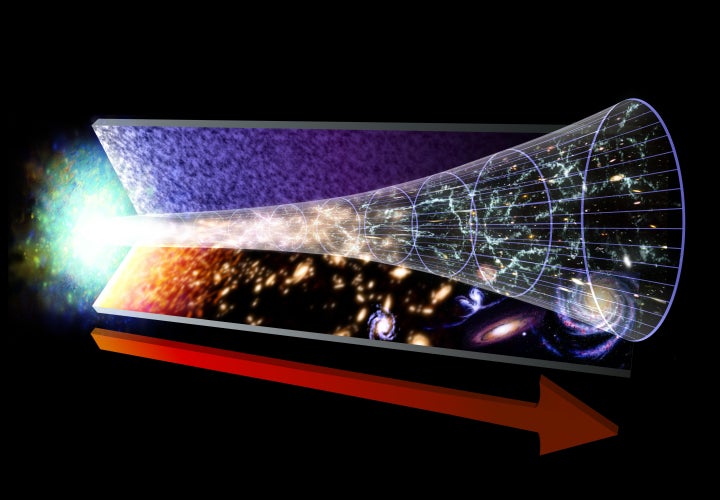Studying the origins of the universe helps physicists understand minuscule, subatomic systems—and vice versa.
By Mark Paris
In physics’ pursuit of ever-more-complete and detailed descriptions of our universe, we’re always on the lookout for new tools.
Cosmology, the study of the universe at gargantuan distances, has recently become good enough to test our understanding of quantum mechanics, which describes minuscule, subatomic systems. A possibly surprising consequence is that quantum mechanics, in turn, helps cosmologists understand observations of the vastness of space, including those soon to be made with forthcoming “extremely large” telescopes.

Bringing the very small and the very large together using newly available, precise cosmological tools potentially allows physicists to better understand the building blocks of nature — and to probe what lies beyond our current knowledge of them.
Let’s start with a crash course in cosmology. A few seconds after the Big Bang created the universe 13.8 billion years ago, the universe — the totality of everything — was a thick, 10-billion-degree cosmic “soup” of subatomic particles so energetic they refused to bind together. All that energy forced the universe outward, expanding and cooling the soup and generating the first light nuclei — the interiors of hydrogen, helium, and lithium atoms.
That process is much like what happens in a thermonuclear reactor, which produces energy by fusing light nuclei into heavier ones. In the early universe, we call this fusion process Big Bang nucleosynthesis — abbreviated BBN with the added complication that while neutrons and protons are fusing together to make heavier elements, they are constantly battered by energetic particles — mostly photons (light) and neutrinos but possibly other, unknown particles. The amounts of hydrogen, helium, and lithium that are made depend on what these other particles might be. By studying the high-temperature and high-pressure environment of the early universe during BBN, we hope to better understand the particles present in the early universe and how they interact with each other.
At Los Alamos National Laboratory, we have 70-plus years of research in nuclear physics. This, coupled with our ongoing mission to maintain the safety and integrity of the nation’s nuclear stockpile, the lab has a vested interest in knowing everything about the subatomic world, from now to way back then. Experiments on subatomic particles here have led physics deep into the realm of the tiny, where quantum mechanics governs the rules of the game. Information from these experiments feeds computer codes that consume months to years of running time on some of the world’s fastest supercomputers as they simulate all the known interactions among particles and radiation in extreme nuclear events.
Anticipating a trove of information that will soon come from the next generation of huge telescopes and other instruments studying the early universe, myself and a team of physicists and astrophysicists here at Los Alamos realized we could use laboratory supercomputers to simulate BBN and the early universe to unprecedented precision. Working with collaborators at leading universities around the country, we recently developed such a code, called BURST. It describes the universe from a time of a few seconds after the Big Bang to several hundred thousand years later.

This image represents the evolution of the Universe, starting with the Big Bang. The red arrow marks the flow of time.
BURST allows physicists to study the microscopic, quantum nature of fundamental particles — like nuclei and the ghostly, weakly interacting neutrinos — by simulating the universe at its largest, cosmological scale. BURST simultaneously describes all the particles present in the early universe as they develop, tracking their evolution, particularly the amounts of light nuclei fused in the cosmic soup.
Then physicists compare these simulations to the conditions in the actual universe as observed by astronomers. The new, extremely large telescopes that will come on-line within the next five to 10 years will dramatically increase our ability to measure Big Bang-era particle abundances, confronting the BURST code’s predictions with observational data of increasing precision. Discrepancies between what BURST predicts and what’s observed in these telescopes could be indications of new physics, an enticing prospect to deepen and further our understanding of nature.
BURST also opens up investigations into exotic fundamental particles that either haven’t been observed or remain mysterious. These include neutrinos, which are known definitively to exist but are only partly understood, and “sterile” neutrinos, for which we only have hints of their existence. They may in fact be the “dark matter” that makes up about a quarter of all of the matter and energy in the universe but that has never been directly observed.
Another puzzle BURST might help solve is the so-called lithium problem: Astronomical observations show that the universe has considerably less lithium than the prevailing standard models predict. BURST might be able to illuminate this discrepancy between predicted and observed lithium abundances.
This early universe research here at Los Alamos exploits cosmological physics to gain insight into the physics of nuclei here on Earth. Accurately knowing the nuclear reaction rates of hydrogen, helium, and lithium is important for a variety of applications central to the Laboratory’s earthly mission in nuclear safety, basic science, energy, and security. Nuclear reaction rates determine, for example, when an assembly of nuclear material may cross the delicate threshold between stability or criticality, a runaway radioactive state resulting in an explosion.
Having a better understanding of the nuclear reactions may just tell us whether our current picture of the foundations of physics is complete. Finding out our picture might not be complete, which might be every physicist’s hope, would make for another interesting period of discovery ahead.
Mark Paris is a physicist in the Nuclear and Particle, Astrophysics and Cosmology group at Los Alamos National Laboratory and the principal investigator BURST, a Laboratory Directed Research and Development, Exploratory Research project.
